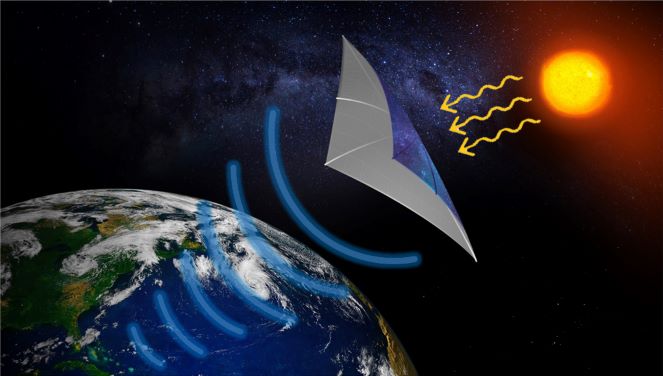Japanese satellite will beam solar power to Earth in 2025
Japan's upcoming space-based solar power demonstration will beam power to Earth next year.

LONDON — Japan is on track to beam solar power from space to Earth next year, two years after a similar feat was achieved by U.S. engineers. The development marks an important step toward a possible space-based solar power station that could help wean the world off fossil fuels amid the intensifying battle against climate change.
Speaking at the International Conference on Energy from Space, held here this week, Koichi Ijichi, an adviser at the Japanese research institute Japan Space Systems, outlined Japan's road map toward an orbital demonstration of a miniature space-based solar power plant that will wirelessly transmit energy from low Earth orbit to Earth.
"It will be a small satellite, about 180 kilograms [400 pounds], that will transmit about 1 kilowatt of power from the altitude of 400 kilometers [250 miles]," Ijichi said at the conference.
Related: Space-based solar power may be one step closer to reality, thanks to this key test (video)
One kilowatt is about the amount of power needed to run a household appliance, such as a small dishwasher, for about an hour, depending on its size. Therefore, the demonstration is nowhere near the scale required for commercial use.
The spacecraft will use a 22-square-foot (2 square meters) onboard photovoltaic panel to charge a battery. The accumulated energy will then be transformed into microwaves and beamed toward a receiving antenna on Earth. Because the spacecraft travels very fast — around 17,400 mph (28,000 km/h) — antenna elements will have to be spread over a distance of about 25 miles (40 km), spaced 3 miles (5 km) apart, to allow enough energy to be transmitted.
"The transmission will take only a few minutes," Ijichi said. "But once the battery is empty, it will take several days to recharge."
Breaking space news, the latest updates on rocket launches, skywatching events and more!
The mission, part of a project called OHISAMA (Japanese for "sun"), is on track for launch in 2025. The researchers have already demonstrated wireless transmission of solar power on the ground from a stationary source, and they plan to conduct a transmission from an aircraft in December. The aircraft will be fitted with an identical photovoltaic panel as will be flown on the spacecraft and will beam down power over a distance of 3 to 4 miles (5 to 7 km), according to Ijichi.
From concept to reality
Space-based solar power generation, first described in 1968 by former Apollo engineer
Peter Glaser, has been considered science fiction. Although theoretically feasible, the technology has been seen as impractical and too costly, as it requires enormous structures to be assembled in orbit to produce the required power output.
But according to the experts speaking at the conference, that situation has changed as a result of recent technological advances and the urgency to decarbonize the world's power supply to thwart climate change.
Unlike most renewable power generation technologies used on Earth, including solar power and wind energy, space-based solar power could be available constantly, as it would not depend on weather and the time of the day. Currently, nuclear power plants or gas- and coal-fired power stations are used to cover demand when the wind stops blowing or after sunset. Improvements in technology could help partially solve the problem in the future. But some pieces of the puzzle are still missing to secure a seamless carbon-neutral power supply by the middle of this century as stipulated in international climate change agreements.
Developments in robotic technologies, improvements in the efficiency of wireless power transmission and, most importantly, the arrival of SpaceX's giant rocket Starship could allow space-based solar power to become a reality, the experts said at the conference.
Last year, a satellite built by Caltech engineers as part of the Space Solar Power Demonstrator mission beamed solar power from space for the first time. The mission, which concluded in January, was celebrated as a major milestone.
Many more space-based solar power demonstration projects are in the pipeline. The technology is studied by space and research agencies all over the world, including the European Space Agency, the Defense Advanced Research Projects Agency and the U.S. Air Force. Commercial companies and startups are also developing concepts, harnessing the availability of Starship and the emergence of advanced space robotics.
However, not everyone is enthusiastic about the potential of space-based solar power. In January, NASA released a report questioning the feasibility of the technology. The difficulty and amount of energy required to build, launch and assemble orbital power stations mean the energy they produce would be too expensive — 61 cents per kilowatt-hour, compared with as little as 5 cents per kilowatt-hour for Earth-based solar or wind energy.
In addition, the overall carbon footprint of the power production and the amount of greenhouse gas emissions generated by rockets taking those assemblies into orbit make space-based solar power much less climate-friendly than technologies used on Earth. For example, a gigawatt-scale spaceborne solar power station, such as the CASSIOPeiA concept plant proposed by the U.K. firm Space Solar, would need 68 Starships to get to space.
Join our Space Forums to keep talking space on the latest missions, night sky and more! And if you have a news tip, correction or comment, let us know at: community@space.com.

Tereza is a London-based science and technology journalist, aspiring fiction writer and amateur gymnast. Originally from Prague, the Czech Republic, she spent the first seven years of her career working as a reporter, script-writer and presenter for various TV programmes of the Czech Public Service Television. She later took a career break to pursue further education and added a Master's in Science from the International Space University, France, to her Bachelor's in Journalism and Master's in Cultural Anthropology from Prague's Charles University. She worked as a reporter at the Engineering and Technology magazine, freelanced for a range of publications including Live Science, Space.com, Professional Engineering, Via Satellite and Space News and served as a maternity cover science editor at the European Space Agency.
-
Classical Motion This will be interesting to see. Especially the receiving antenna if I understood correctly. Does the orbit need to be synced, or phased with antenna location? And maybe angle?Reply
I think I understand this concept, to replace fossil fuel. And eventually 24/7 solar power from space in the future. Unfortunately replacing fossil fuel is not the problem. If we replaced all fossil fuel tomorrow............how are you going to meet demand? And believe it or not, demand is just beginning.
And to my way of thinking and I know I am weird, but reflecting sunlight to this "over-warmed planet", is not a good idea. Solar would only be green is if catches incident light.
As for space reflectors, if we could orientate(can) and focus(doubtful) sunlight, it might be useful for clearing our space debris. A focused beam should illuminate the small stuff, maybe even accelerate/ionize it to de-orbit. Cleaning up some of our mess might be done with light beams. -
Jan Steinman ReplyOne kilowatt is about the amount of power needed to run a household appliance, such as a small dishwasher, for about an hour…
You're confusing power with energy.
A kilowatt is a unit of power, or the instantaneous product of force and flow, such as 100 volts causing a current of ten amps. A kilowatt will power that appliance as long as the proper voltage is applied, not just an hour.
A kilowatt-hour is a unit of energy, or power times duration. Running an electric dish washer — plus an electric water heater for the diswasher's hot water — for an hour will consume about a kilowatt-hour of energy. -
Alaintha Reading this article, I kept thinking, what about the size, will they continue to expand and grow? Is one enough? I highly doubt one solar power plant will be enough for most countries. How many other countries will copy this engineering feat and send one up on their own? This space power plant, how will it be affected by " space trash" that falls to earth? What do repairs cost?Reply
I am not a scientist but I do love my telescope, watching the skies and my favorite stars. Scientists have stated that the "solar power" equipment will appear as just a star, I disagree.
What about the "falling trash" from repairs? Or worse, thrown out of orbit from other space trash or some thing larger than an a small meteorite ?
As science reaches for answers to accommodate the growth of Earth's inhabitants, how far will it go? I still have many questions about sending solar power plants to supply beams down to us. If I live long enough, will Earth be entirely surrounded by not only satellites, but now space power plants vying for orbit? How far will this congestion grow? -
billslugg The congestion will grow until the outcry pushes back. There is heated debate going on right now.Reply
I believe the environmental concerns around dosing any spot on the Earth with that much microwave radiation are going to scuttle it. Fusion or thermal drilling will get there first. -
Kipi I think that solar energy collection in space will never be strategically feasible as long as there is war between nations. If your entire (or most) energy supply depends on such space structures, your enemy may easily compromise you by destroying your photovoltaic station with one nuke or several conventional missiles. I think this will become (theoretically) possible only if humanity transcends war ( in other words don't hold your breath waiting for this to happen).Reply -
Unclear Engineer I agree with Kipi regarding the strategic implications of space based solar.Reply
However, the opposite is true for DISTRIBUTED ground based solar. If everybody has the ability to work while off-grid, it would not be possible for an enemy to shut down the whole country's electrical system as Russia is currently seeming to try to do in Ukraine right now. -
Kipi I agree with UE in that the correct trend would be a gradual shift to decentralized independent small units with as much diversification as possible, some solar, some wind, some hydroelectric, some geothermal and all should be inter-linked into a more resilient system. However, it will take some time and resources and scientific advances until this becomes a reality.Reply -
Classical Motion Has any here seen recent photographs of Indian and Chinese cities? I spent a year on the Mojave desert in 1969. LA never looked that bad. Can you imagine 10 years from now with all that coal expansion? Geothermal is their only solution. Without ventilators.Reply
Demand will bring inexpensive holes. The tech for generation is the same for coal. And no future supply lines, storage or fees.
Maybe even some year round creeks and wetlands in arid areas. Maybe even replenish large desert lakes. -
bolide There's enough solar energy hitting Earth now. We don't need a hugely expensive and polluting system to just harvest a bit more of it from orbit. Every parking lot, large roof, irrigation canal, and reservoir behind a dam could be covered with solar panels. For the same money an orbiting system would cost, we could generate more power at the surface, with hugely less pollution.Reply
